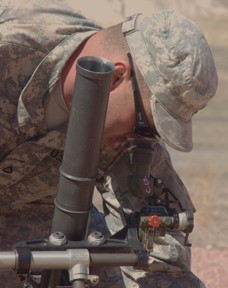
CAMP GUERNSEY, Wyo. - Forward observers and mortar men from 3rd Squadron, 89th Cavalry Regiment, 4th Brigade Combat Team, 10th Mountain Division used their skills in an Afghanistan-like environment while training at Camp Guernsey, Wyo. April 8.
FO and mortar teams assigned to Troop C, 3rd Sqdn conducted battle drills using their skill sets in terrain and altitudes similar to Afghanistan. The teams road marched to an obstacle course and negotiated it with Troop C. They then broke away from the rest of the troop after zeroing their weapons and confirming their zeroes on a nearby known-distance range while the rest of the troop continued to fire their weapons.
"It was kind of impromptu, since we have to do some shooting with our infantry unit; but our main focus is to call for fire to give our infantry maneuver element stronger control of the battlefield," explained Sgt. Matthew Mihacsi, Troop C fire support NCO. "If they come into contact with the enemy, our FOs will be accurate and proficient enough to engage targets at a greater distance than their rifles can and with better accuracy than any other FO team, because we strive for the best."
Mihacsi referred to the mortar crews as FOs' stepbrothers. He said although the mortar men are infantry Soldiers and FOs are artillerymen, it is standard to call for mortars before any other type of fire support.
Pvt. Chris Whitehair, an ammo bearer on a Troop C mortar team, said mortars are their primary weapons. "Although we are trained as infantrymen and possess the skills of infantrymen, we receive additional training on three mortar weapons systems," he said.
Mihacsi said FO teams consist of an FO and a radio telephone operator. He explained that in conventional warfare an FO team's first responsibility is to occupy an observation post. The teams locate an OP on a map, reconnoiter the site, obtain aerial photos and then secure the OP.
"After an FO team has secured an OP, they must conceal themselves, usually on the opposite side of a hill from the enemy," he said. "We picked out an area. We all noticed it, and that gave us our best spot for concealment," explained Mihacsi. "For training purposes, we want to be able to see more of the area, so I got my team set up on the forward side of the hill."
After concealing their position, a team plots their grid location and sends it and a terrain sketch to higher headquarters. Then they start identifying likely avenues of approach and look out for high value targets. The FOs create target lists and prepare to transmit them to mortar crews as soon as the mortars are set up.
Mihacsi has deployed to Iraq three times, and most of his FO Soldiers have deployed too. Although he has not deployed to Afghanistan yet, Mihacsi knows how similar Camp Guernsey's terrain is to Afghanistan and he appreciates the training opportunity.
"The mountainsides are just like Afghanistan," said Mihacsi. "I did my research, and I asked my first sergeant. He has been to Afghanistan, and he told me this is exactly what it looks like.
"We take every opportunity we can to walk up the side of a hill, set up, and see what it looks like," continued Mihacsi. "We execute our missions as best as we can."
Another similarity between Afghanistan and Camp Guernsey is the "thin air." It stretches out one's lungs, and Soldiers suck wind for a couple of minutes after walking up a mountain.
"A primary goal for the FOs during their training is to adjust their eyes to properly calculate ranges," said Mihacsi.
"What appears to be a distance of 1,000 meters can actually be about 2,000 or 3,000 meters because flat ground and rolling hills are deceiving to depth perception."
Pfc. Jesse Vaughn, Troop C mortar team gunner, said he thinks training at Camp Guernsey has provided an environment similar to Afghanistan.
So far during this deployment, he said he has enjoyed training in the altitude and terrain and finding mortar positions from which to fire.
"I think it is awesome," said Vaughn. "I am receiving a lot of leadership training and decision-making responsibilities here. Using the terrain and elevation here is really going to help us in Afghanistan."
Mihacsi said training at Camp Guernsey is helping make his FO teams' Soldiers better at their jobs. "We save lives," said Mihacsi. "If we take out a mortar tube or a platoon-sized enemy element, that means we probably saved one or two of our Soldiers from getting into a direct-contact fight and losing their lives."

Social Sharing